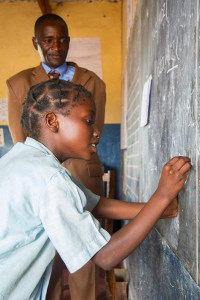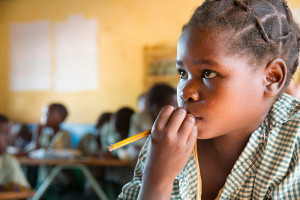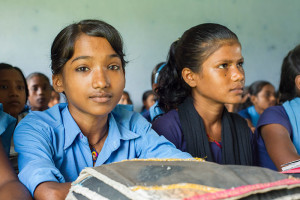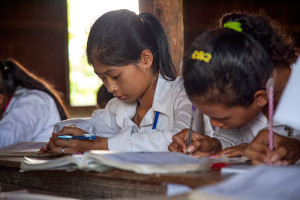[vc_row][vc_column width=”1/1″][vc_column_text]
Let Girls Learn is U.S. & global priority
By Jillian Slutzker
[/vc_column_text][/vc_column][/vc_row][vc_row][vc_column width=”2/3″][vc_column_text] Globally, 62 million girls are out-of school, according to UNESCO. Limited access to education, and cultural and economic barriers preventing girls from attending school, cost the world 62 million untapped opportunities to improve family income, a community’s prosperity and national growth and stability.
Globally, 62 million girls are out-of school, according to UNESCO. Limited access to education, and cultural and economic barriers preventing girls from attending school, cost the world 62 million untapped opportunities to improve family income, a community’s prosperity and national growth and stability.
To change this situation, the Obama Administration announced its new Let Girls Learn initiative to boost school attendance and graduation rates for adolescent girls globally.
“This initiative is particularly critical in light of recent and ongoing attacks against girls who simply wish to attend school and receive a good education,” says Cris Revaz, Senior Education Counsel at Creative Associates International, which commends and fully supports the Administration’s Let Girls Learn initiative.
Revaz says community-led solutions that protect girls attending school are critical, citing recent attacks like the abduction of school girls by Boko Haram in Nigeria last year. “A safe and secure school where girls and boys are free from bullying, violence and other human rights abuses is a fundamental prerequisite for learning,” he says.
Studies have shown that the more time a girl spends in secondary school the more likely she is to achieve a higher level of economic stability and the less likely she is to enter an early marriage, contract HIV/AIDS or get pregnant as a teen.
“Adolescence is a formative time for girls when they have a chance to equip themselves for a better future. Education is vital” says Rekha Mehra, Gender and Development expert at Creative.
In partnership with the U.S. government, multilateral development organizations, local, national and international partners, Creative has for decades advanced access to quality education for women and girls from Afghanistan to Malawi to Uganda, recognizing that the benefits of girls’ education are reaped by the individual, her family, her community and her country.
Long-lasting & communal benefits
 The knowledge an adolescent girl gains in the classroom goes beyond textbooks or even technical job skills and can have a profound positive effect on a girl’s future, including her sexual health and physical safety.
The knowledge an adolescent girl gains in the classroom goes beyond textbooks or even technical job skills and can have a profound positive effect on a girl’s future, including her sexual health and physical safety.
“Research has proven that girls who complete secondary school gain self-confidence and are able to understand and defend their basic rights and navigate relationships where they become less exposed to gender-based violence,” says May Rihani, a global leader in girls’ education and women’s rights and former Co-Chair of the UN Girls’ Education Initiatives.
In fact, the spillover effects of an educated girl reverberate throughout her community, says Creative’s Mehra, noting that just a couple years of additional schooling can bring significant improvements for women—better health outcomes, better work options, higher earnings and delayed marriage age. It even brings positive changes for the next generation from lower rates of infant mortality to higher education attainment for the children of educated women.
Closing the gap at adolescence
 In recent years, gaps between girls’ and boys’ primary school enrollment have narrowed in two-thirds of countries, according to UNICEF. But as students move to secondary school, girls drop out at greater rates than boys and the gender gap widens, which will have significant detrimental effects on countries’ economic progress as their potential workforces are, in some cases, operating with half as many workers as they could be.
In recent years, gaps between girls’ and boys’ primary school enrollment have narrowed in two-thirds of countries, according to UNICEF. But as students move to secondary school, girls drop out at greater rates than boys and the gender gap widens, which will have significant detrimental effects on countries’ economic progress as their potential workforces are, in some cases, operating with half as many workers as they could be.
“We still have a way to go in women’s economic participation, which has been virtually stagnant since the 1995 Beijing Women’s Conference,” says Mehra. “Only 55 percent of women are in the workforce compared to 82 percent of men. Women’s work is mainly in the informal economy—low-paid and unstable. Education is the route for adolescent girls to be prepared for better paid and more stable work in the formal economy.”
Community-led solutions
 With a focus on capacity building and sustainable local solutions to bridge the adolescent gender gap in education, the Let Girls Learn initiative will focus on community-led solutions.
With a focus on capacity building and sustainable local solutions to bridge the adolescent gender gap in education, the Let Girls Learn initiative will focus on community-led solutions.
“Community-led solutions are definitely smart and, perhaps, even necessary,” says Mehra, noting that complex, interrelated factors often combine to keep girls from attending school. These factors include poverty, lack of understanding of the value of education, religious or cultural restrictions on girls’ mobility, concern for girls’ safety and norms that favor boys’ education.
In many places, when girls reach puberty, cultural norms lead them to drop out of school and get married, says Rihani. The Let Girls Learn initiative, she says, aims to support these most vulnerable girls at greatest risk of dropping out who are up against societal pressures.
Part of the solution to overcoming these societal pressures, says Mehra, is to secure community buy-in in for programs that keep their daughters and sisters in school.
“In order to get more girls to school, we need to change attitudes and norms that pose barriers to school attendance,” says Mehra. “We need to educate parents, families and communities about the value of girls’ education, and get their buy-in so we can support them in devising their own solutions to local barriers.”
With Let Girls Learn in full swing, the international development community can expect more investment in adolescent girls’ education, says Rihani, noting that the private sector will also have a key role to play in these efforts.
These is a great need for this concerted effort with the Let Girls Learn initiative, says Mehra. As an example of this need, she cites that of the 126 million illiterate youth (15-24 years), 62 percent are female, which is almost the same proportion as adult women who are illiterate, according to UNESCO.
“We don’t want female disadvantage to continue,” says Mehra. “We want change that promotes equality and gives girls access to the many benefits of education.”[/vc_column_text][/vc_column][vc_column width=”1/12″][/vc_column][vc_column width=”1/4″][vc_widget_sidebar sidebar_id=”sidebar-primary”][/vc_column][/vc_row]